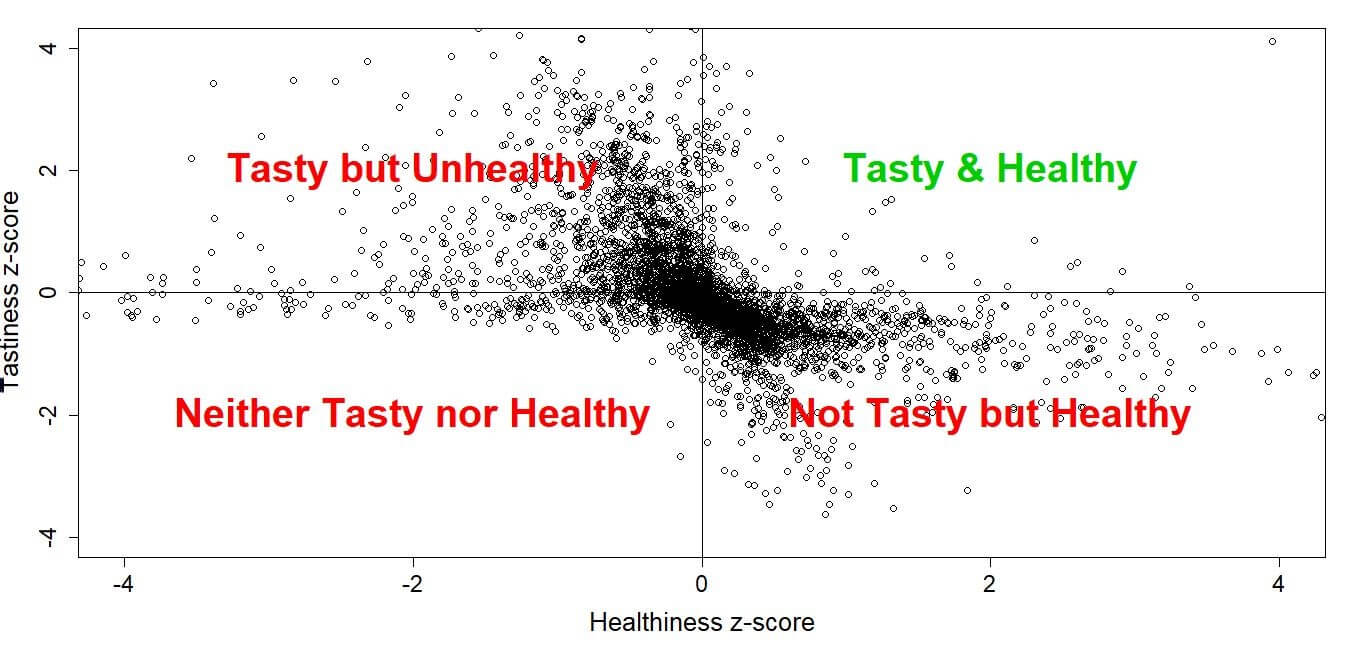Author: Dr. Jeffrey S. Young, Assistant Professor, Agribusiness Economics, Murray State University
If I described this article as something like “datalicious”, would that be in poor taste? Sorry for the pun; I’ll try to make the rest of this piece more palatable.
People liking things that taste good seems obvious, but it’s actually something that too frequently gets assumed by folks interested in studying diets and health. Offended by this seemingly obvious oversight, I set out to measure food tastiness. There were obvious starting points such as “more sugar = more tasty”, and “more vitamins = raw veggies = not so tasty”, but I wanted something more.
How does an additional gram of sugar impact tastiness? How about sodium? There had to be a way to get more granular with it. As I’ll detail below, I managed to pull it off; my peer-reviewed article in Food Policy is now available. But, so what? What does my formula bring to the table (pardon another food pun)?
Who Cares?
For one, food marketers care. Sure, they watch for patterns of behavior and demand them to emerge, but what if they could predict those patterns ahead of time, ahead of the competition, and ahead of restrictive legislation or new consumption taxes?
The chief audience of the article was food policy researchers. Nearly all of the work I’ve seen done about the favorite “tax junk food, subsidize vegetables” movement looks at sugar-sweetened beverages or “SSB”, and some mysterious portfolio of fresh fruits and vegetables, or “FV”. The abbreviations “SSB” and “FV” seem to be everywhere if you want to read anything at all on the matter, but that is not how real people eat … a little bit of SSB and a whole lot of FV, anyone?
What is the Impact?
This tastiness formula is the first of its kind. How do I know that? I caught equal amounts of criticism and laughter when I first unveiled it, and I also compulsively checked for anybody having tried to do something like this before and came up empty-handed every time.
Now, for that equation … tastiness for a given food item can be computed as a combination of the nutrient levels per 100g of the food:
Tastiness = 8.82 + 4.43(added sugar) + 0.10(sodium) + 11.27(saturated fat)
- 8.74(moisture) - 0.64(vitamin C) - 0.06(vitamin A) - 0.17(vitamin K)
- 0.12(calcium) - 9.63(M.unsaturated fat) - 8.17(P.unsaturated fat)
- 12.43(protein) + 0.67(caffeine) - 8.99(carbs) - 0.23(choline)
- 1.05(magnesium) - 1.88(natural sugar)
If someone wants to run the formula themselves and see how the end results stack up against their own personal taste system, I invite them to do so! There’s also a list of >150 foods listed in the Appendix if you don’t feel like doing the math ‘from scratch’ (cooking pun intended).
Why is This News?
Others have claimed confidently that “taste is random” and should just be assumed away. One paper claiming just that is coauthored by my major professor and very dear mentor. The claim was essentially that we cannot observe nor measure taste, but we can qualitatively look at consumers’ diets. One of my favorite quotes from that paper is,
“…while someone choosing bran flakes for breakfast may do it strictly for the taste, it is unlikely anyone chooses chocolate-coated sugar bombs for nutrition. In other words, purchasing bran flakes may not be a highly accurate indicator of a demand for nutrition, but purchasing sugar bombs is a good indicator of its absence.”
That is one satisfying mic-drop of an excerpt, at least to me. But it gets at something most people miss: suppose the people buying the chocolate-coated sugar bombs really are doing so in the full knowledge that they aren’t exactly healthy. Reasonable enough, right? So, why are they buying them? Are they cheaper than the bran flakes? Certainly not the last time I checked! Do they store better? Doubtful. Are they easier to prepare, i.e., pour into a bowl of milk? I would wager not. Where does that leave us? Well, they must taste better, pure and simple.
Find some proxy cereals the next time you grocery shop and look at the leading nutrients for these two competitors. I suspect you’ll find a showdown something like: fiber versus sugar. One certainly tastes better than the other, in its own right (we don’t add pure fiber in our coffee or on grapefruit to improve the taste). What if there were other nutrients like this, some that add to and some that detract from taste? Well, I figured the best way to answer such a question was to get data on folks who (1) tell us their valuations of tastiness and healthiness when considering foods to eat, and (2) told us what they ate.
How Does It Work?
I wrote a computer program to answer the question: do consumers who prioritize taste over nutrition eat more sugar? Salt? Fat? Protein? Fiber? Vitamin K? You get the idea. And it turns out, yes. Sugar, sodium, and the like were consumed in significantly higher quantities (per total grams of food eaten over a two-day period) by these people, whereas calcium and various vitamins were significantly less consumed. The opposite was true for consumers who prioritized nutrition over taste!
After that comes a bit of black magic, but in short, the relationship between taste-prioritization and the informed or “data-driven” list of nutrients can be projected from human beings onto individual food items.
For instance, because adults identified as taste-prioritizers ate more sugar, foods high in sugar should taste better (to the average American) than foods low in sugar. Vice versa for foods high/low in dietary fiber. As for the rest of the nutrients in the equation? Here’s a quick shortcut: in the equation, any nutrient with a “+” in front of it was identified as “taste-enhancing” by the algorithm, whereas a nutrient with a “-“ in front of it detracts from a food item’s palatability.
Sure enough, the top-scoring foods in the results include double bacon cheeseburgers and devil’s food cake; the bottom of the list has things like raw celery and dry oats. Figure 1 shows the standardized values of the tastiness index and contrasts it with standardized values of a “healthiness” index from another paper written by nutrition researchers.

Figure 1. Visualizing the healthiness-tastiness tension.
Makes sense, right? The overwhelming majority of foods eaten by Americans in 2007-2010 are either tasty and bad for you (e.g. deep dish meat lovers pizza), or healthy and unappealing (e.g. raw watercress). There’s a fine line to walk here, but it’s not impossible to achieve both – but for what price? That’s another story for another time…
Where Does This Leave Us?
The next time somebody says to you, “Well, there’s just no accounting for taste”, feel free to send them my way! Also, cautiously bear the general, qualitative formula in mind the next time someone is appealing to the taste sense as a means for persuasion. After all, we do that all the time with nutritional value. Some common examples, “this has less sugar, so it’s healthier”, “oh, good, this one is reduced fat”, or “that’s a good source of vitamins”.
It’s also nice to have a tool for reference when thinking about taste. For instance, is the tug-o-war between tastiness and healthfulness of foods a meaningful factor underlying the obesity epidemic in the U.S.? If so, just how meaningful? This question is briefly addressed in the paper, but it is an increasingly important one for both policymakers and various players in the food industry.
Whatever the case, one thing’s for sure: the consumer research world needs more sweet puns. Cantankerous old academics demanding dry, flavorless writing just need to stop being so salty. Okay, now I’m done.
ConsumerCorner.2021.Letter.31




